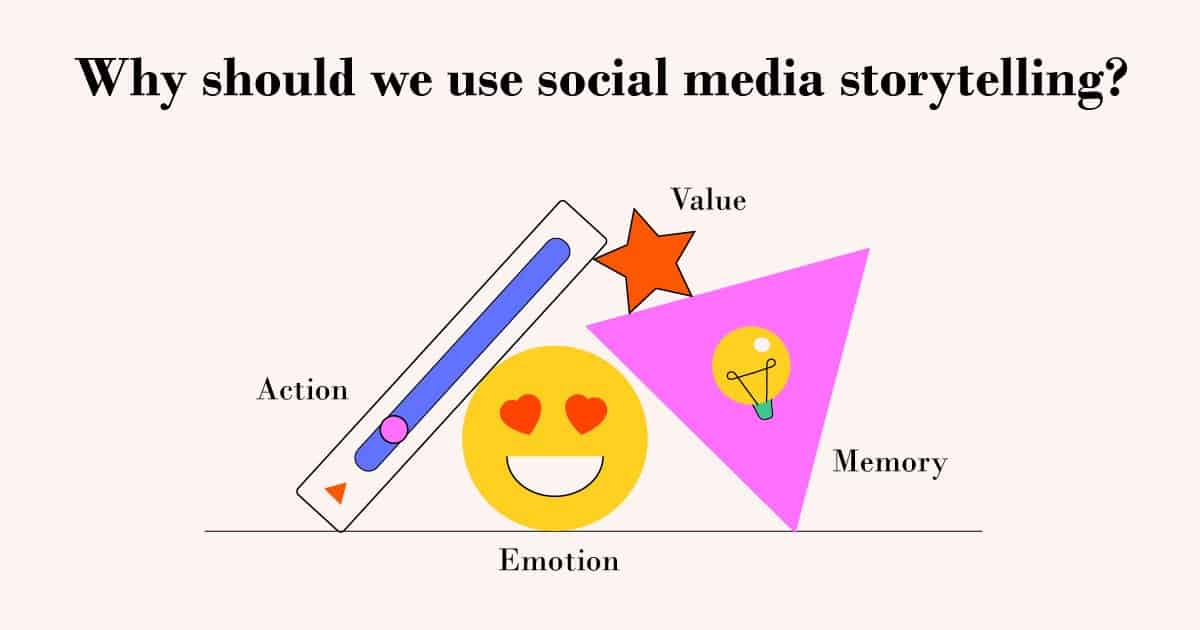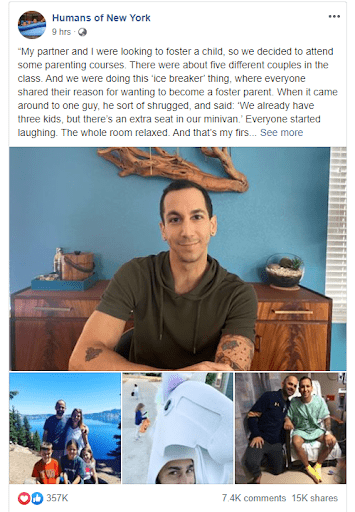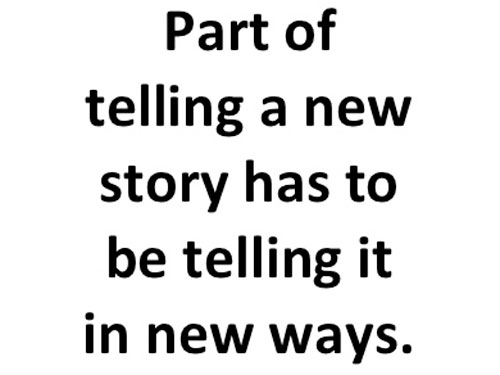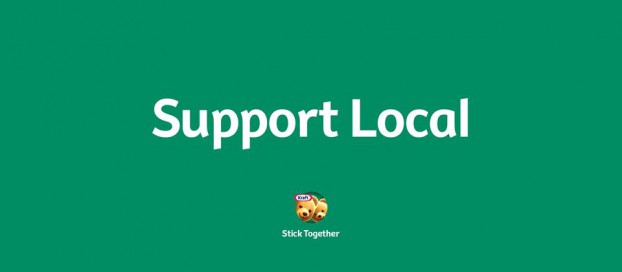New Normal Marketing: Cutting Through the Noise Using Social Storytelling
Podcast: Play in new window | Download
Subscribe Today RSS
With stage one of re-opening officially underway here in Ontario, many businesses are scrambling to get their doors open and to reach out to their audience to let them know.
This week we're taking a look at some strategies for social storytelling and tactics for how to break through the noise on social media, as every business is reaching out to their audience at the same time.
What are some challenges you've been finding? What strategies have been working for you? Join in the conversation and share your experiences with us!
Subscribe if you'd like to stay up-to-date and be notified when our new content drops - we have weekly live streams on Facebook and podcasts you can take on the go.
What is Social Storytelling?
For years we've been inundated by aggressive marketing, with the focus blatantly on promotion and selling. Things have changed. Marketing has evolved. Social media allows consumers to communicate directly with brands, and the focus of marketing has shifted to an emotional appeal with goals ranging from community building to brand awareness, by simply telling your audience what your brand is all about.

Social media storytelling can come in so many different shapes and sizes, and can be drastically different, depending on the platform you're engaging with.
For example, if your audience is on Instagram (or Pinterest), you'll want to tell your brand story with beautiful, curated imagery.

A great example of a visual storytelling post on Instagram about travel.

Here is an example of creating a story by curating your posts into a tiled story that creates a theme.
On Facebook you'll want to take a casual, community-minded tone, tell relatable lifestyle, human stories, and share captivating imagery or informative videos.

From the Humans of New York Facebook Page. Their post is quite long and requires people to click “See more,” but it gets significant engagement.
What's New
We've scoured the internets for some juicy tidbits of knowledge and have compiled a list of great reads about social media storytelling and different strategies you can use for inspiration and insights. Let's dive in.

- How To Tell a Story On Social Media - Some really great insights by the social media master of genuine storytelling, GaryVee. He talks about our on-demand culture, Hollywood vs social media storytelling, and the most valuable commodity to us all and how we spend it - time.
- How to Leverage Storytelling to Increase Your Conversions - Another great thought leader we love here at the Hive is Neil Patel. In this blog post he talks extensively about the art of storytelling, content segmentation, how audience engagement can define your brand, and how to use storytelling to increase conversions.
- How to engage customers on social with brand storytelling - This article talks about the importance of knowing your audience, how to create resources that relate to your brand to use as content to share, using content from your community, and giving back.
- Social Media Storytelling - How To Do It Right? - This article has a ton of great content on the nature of storytelling, with insights into the different approaches of social media storytelling, breaking down the distinct voices for the most popular platforms, such as Facebook, Instagram, Twitter and YouTube.
- 3 Brilliant Examples of Brand Storytelling You May Have Missed - This article talks about brand storytelling, outlining 3 great examples and providing some very informative stats on how the human brain takes in and retains information, highlighting the importance of storytelling and the incredible impact of visual storytelling.
Social Media Road Map
We understand how difficult it can be starting out as a new small business trying to build brand awareness online, so we've put together a handy road map to help you navigate the process of setting up and executing social media campaigns. You can access a mock-up document here, as well.
Research - Discovery - Analysis
The objective of this stage is to determine and lay out your company's mission, vision, and audience. It's important that this is set in stone so you can unify your message and understand your weaknesses and strengths.
Define your company, your mission, vision, message, target audience, and your strengths and weaknesses.

WordPress uses clever imagery to convey the use of plugins on their platform.
Competitive Analysis
All brands should understand who their competition is, so they can see how they measure up. A good analysis will help you see areas of opportunity for your brand or area differentiators that make you unique.
Understanding how your brand can stand out will help you create content that will resonate with your audience.
Play upon your differences to stand out. Define your competition, their strengths, your company's competitive edge, what your company does better, can do differently, and potential roadblocks.

Plan Building - Objectives
It's time to think outside of the typical marketing campaign, and instead, focus on what your goals are. Understanding the difference between each objective will help you create messaging or content to drive engagement and optimization.
Having strong objectives will also help you determine if your posts are successful or not.

Visual stories and communication (e.g. infographics, videos, memes, screenshots) gets widely shared on major social media channels.
- Increase brand awareness - To create authentic and lasting brand awareness, avoid solely publishing promotional messages. Instead, focus on content that emphasizes your personality or values first. Focus on the idea of surprise and delight.
- Lead Generation - Whether online or in-store, followers aren’t going to make social purchases by accident. For example, are you alerting customers about new products and promos?
- Community Engagement - Find ways to grab the attention of your current followers. This means experimenting with messaging and content. Experiment with different hashtags and share those users who have had a great experience with your brand.
- Web Traffic - Whether through promotional posts or social ads, keeping an eye on conversions and URL clicks can help you better determine your ROI from social media. Use a personalized link tracking tool and UTM codes to ensure you are tracking your traffic from social to website. It will give you a better idea of what is converting and what isn't.
- Keyword Research - Do your homework and see what keywords and phrases users are searching for in your category. That way, you can develop content that provides your users with the information they crave.
Measurable Goals

All brands should set targets to measure performance. If you're a new brand, use industry averages to start off and then measure against these monthly, quarterly, and annually to gauge your performance. Below, we have outlined industry averages for coffee retailers.
For example, using the coffee shop example, here is an outline for industry averages for coffee retailers:
| Industry Average Engagement Rate: 0.10% Top Industry Post Type: Photo |
|
| Industry Average Engagement Rate: 0.064% Top Industry Post Type: Video Most Popular Industry Hashtag: #giveaway |
|
| Industry Average Engagement Rate: 1.18% Top Industry Post Type: Photo Most Popular Industry Hashtag: #giveaway |
Execute - Implement - Launch
Now that you have laid out the groundwork, do one last check through all creative, metrics, etc., to ensure consistency and that no steps have been missed along the way.
| CHECK FOR MESSAGE CLARITY AND UNIFORMITY ACROSS PLATFORMS | You must remember to keep your message clear to avoid confusion with your audience. You want to make sure your CTA is understandable and that it is a unified message across all platforms. |
| GRAPHIC UNIFORMITY | Your graphics also need to be defined by brand guidelines and unified across all social platforms and your website. |
| CONVERSION MONITORING | How will you track conversions? Is it through UTM codes or shortened links? Understand the path your customers are taking to purchase, this will help you optimize your messaging along with the correct social platform to use. |
| DAILY POSTING WHERE APPLICABLE | What will your posting schedule look like? While posting daily is recommended, perhaps it doesn't make sense for your brand. Do several test-and-learns to ensure you have the right frequency optimized for your brand. |
| REPORTING PLAN: ENGAGEMENT, INFLUENCE, NUMBERS, ETC. | What metrics are most important for your brand? Do you measure success by a large reach, or is it more defined by the amount of engagement you see on each post? Or is it a mix between both? Understanding your KPIs in advance will help you define your boosting strategy. |
Measure - Metrics - Track (Weekly Status Updates)
Below you will find common metrics that you should be tracking monthly to measure your success.
| NUMBER / NETWORK GROWTH | How many new followers did you receive? |
| STATUS: ENGAGEMENT | What post gave you the most amount of engagement? Which one didn't perform as well as you thought? |
| STATUS: INFLUENCE | Where do you stand among your competitors?
You can easily track your performance against your competition to see how your similar target audience responds to different types of content. |
| WHAT'S WORKING? WHAT ISN'T? EVALUATION AND REVISIONS | By reviewing post engagement, brand sentiment, and boost results, you can analyze your test-and-learns to come to a solid conclusion on what is and isn't working, and then adjust. This should be done monthly. |
Goal assessment - Revised Goals - New Goals
Each month you should review all of your accounts to determine how you can optimize or what new content ideas you can test and learn. Social accounts are not stand-alone tactics, they are constantly evolving, and there are always new and interesting ways you can improve your performance.
| Next month, let's try joining Facebook Groups to increase our brand's reach. | |
| Now that we are following 10,000 accounts, let's start grouping everyone into lists so we can stay on top of the conversation and trends. | |
| Let's create an Instagram story roundup of all user-generated content. By tagging more accounts, we may see an increase in followers and reach. |
Feel Good Story of the Week
It's amazing what can happen when people come together. Even the titans are stepping up to help the little ones. Kraft Peanut Butter is currently running a "Let's Stick Together" campaign, giving away ad space they've already bought to local small businesses to help support them.

Not the kind of thing you see from a large corporate company very often. Just gets you in the feels, like a cozy warm group hug. This is the kind of good news we like to share. Keep it up, Kraft, and thanks for being an awesome role model for other corporate giants to follow.

